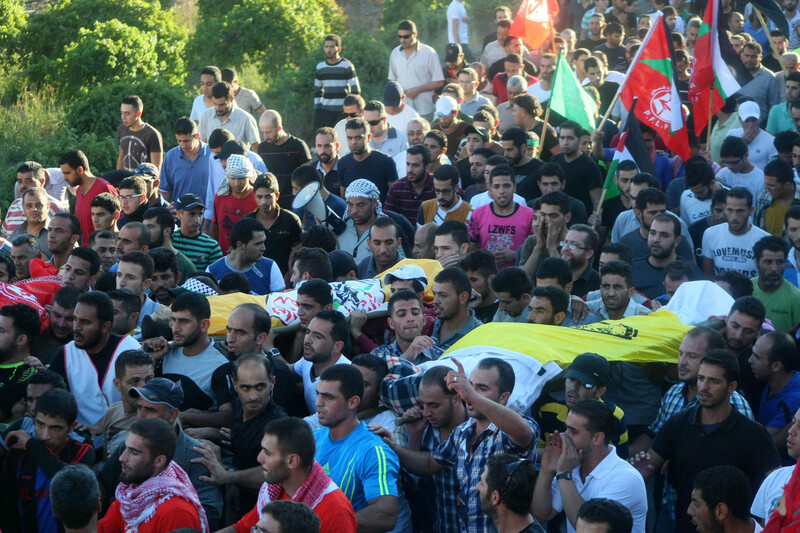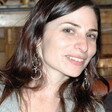Rights and Accountability 25 July 2014

Palestinians in Beit Ommar carry the bodies of three villagers killed by Israeli snipers on 25 July.
APA imagesThree Palestinians were shot and killed today by invading Israeli forces in the village of Beit Ommar near the occupied West Bank city of Hebron during a demonstration in solidarity with Palestinians in the Gaza Strip.
Seven Palestinians — including the three in Beit Ommar — were killed by Israeli occupation forces and civilians during protests across the West Bank in the last day.
In Beit Ommar, an Israeli sniper killed Hashem Abu Maria with live ammunition in the torso at around 3:15pm today.

Hashem Abu Maria “considered defending children’s rights as his purpose in life, not simply as a job,” says Defence for Children International-Palestine. (Photo courtesy of DCI-Palestine)
Abu Maria worked with Defence for Children International-Palestine (DCI-Palestine), leading its community mobilization unit.
DCI-Palestine stated in a press release that “Hashem served as the coordinator of DCI-Palestine’s community mobilization unit, promoting constructive child participation throughout the occupied Palestinian territory. His most recent work focused on Palestinian teens monitoring and documenting child rights violations in Hebron. He is survived by his wife Samira, his son Ayham, 11, and his two daughters, Siba, 6, and Majdal, 13.”
Rifat Kassis, executive director of DCI-Palestine, said: “The DCI-Palestine family is shocked and devastated by the loss of our friend and colleague, Hashem. Hashem considered defending children’s rights as his purpose in life, not simply as a job. That he has become the latest innocent civilian to lose his life at the hands of Israeli forces is a tragedy. We offer our utmost condolences to his family.”

Abd al-Hamid Breigheth was shot and killed by Israeli forces on 25 July in Beit Ommar. (Photo courtesy of Palestine Solidarity Project)
Live gunfire
Speaking with The Electronic Intifada from her home in Beit Ommar on Friday evening Palestine time, Bekah Wolf, co-founder of the Palestine Solidarity Project, said that demonstrations were ongoing since the afternoon, and Palestinians had set fire to the Israeli army watchtower that was built at the entrance to the village.
During our interview, sounds of live gunfire shot by Israeli forces, as well as ambulance sirens, were heard. Wolf said that a youth, perhaps in his late teens or early twenties, was being carried down a hill adjacent to her house by a group of village residents, put on a stretcher by medics, and driven off in an an ambulance.
A few minutes after Wolf and I spoke, Israeli forces shot and killed 28-year-old Eid Abd al-Kadir Fadhelat in the Aroub refugee camp just north of Beit Ommar.
The men, women and children of Beit Ommar have been resisting regular attacks by both Israeli soldiers and settlers for years. Villagers have held weekly demonstrations after Friday prayers demanding an end to Israeli attacks, confiscation of their agricultural land by encroaching Israeli settlements, and the targeting and arrest of village youth.
Listen to this interview with Bekah Wolf, or read the transcript below.
Transcript of interview with Bekah Wolf
Bekah Wolf: I’m Bekah Wolf, I’m an American who has lived in Beit Ommar in the West Bank, which is in the northern Hebron district, off and on for the last almost eight years. And I’m currently here with my four-year-old daughter and my husband, who is from Beit Ommar.
Today, Beit Ommar was having a regular Friday demonstration. There had been a call for larger demonstrations this Friday across the West Bank, in support of the people of Gaza and against the assault on Gaza, but there had actually been unofficial demonstrations in the evenings in Beit Ommar for the past several weeks.
Actually, sorry, it’s a bit odd right now because they [the Israeli army] are shooting live ammunition and I’m trying to get the kids to go inside.
So the Israeli military today came, they were stationed where they’re usually stationed for demonstrations, which is at their military tower which is at the entrance of Beit Ommar. The march started in the middle of town and was marching down towards the watchtower. And I was on the side, standing on the sidestreet where I live, watching as the demonstrators went past, not really participating though my husband was participating. And the military started using live ammunition immediately.
I didn’t even see or smell tear gas, or hear tear gas being fired until after the first person was killed. So rather than using the regular “crowd dispersal weaponry,” which is dangerous enough as it is, but has not been nearly as lethal as today was, they didn’t use it. They clearly had a decision that they were going to shoot people, and shoot to kill people.
So there were actually relatively few injuries, somewhere around ten, and three deaths of people, all of them shot in the torso. I think there’s been a bit of a conflicting report about whether one of them was shot in the head or the torso, but all of them clearly lethally shot in the middle of the town.
There’s more live ammunition right now.
Nora Barrows-Friedman: Bekah, can you describe where your house is located and how close the live ammunition that the Israeli soldiers are continuing to shoot right now is to where you are?
BW: Sure. So my house is down on, as I said, a side street from the main road of the village, but relatively close — less than a quarter of a mile from the front of the village. So I can hear what is happening all the way from the front — from where the military tower is, and on the main road, though I have to actually walk on the main road to see it. I can’t — the live ammunition that’s being shot right now sounds like it’s being shot close to where the watchtower is, so it’s less than a quarter of a mile away. It’s pretty close, although there’s several houses and a hill in between. Unless the military comes closer into the village, we’re safe here.
Earlier today, my daughter was at her cousin’s house, which is a little bit closer to the main street from where our house is, and the soldiers were coming down the side street where I was standing, past the house where she was. Because the military not only was shooting from the watchtower up into the village, but also from somewhere, I don’t know, across the main road. So they were shooting from two perpendicular spots into the demonstration.
From one of the angles, they can actually shoot down into the side street where we live, and were shooting down there, and I saw at least two bullets ricochet off the ground and the stone walls.
I think that where they’re shooting from right now is down closer to — I don’t know if you can hear it, it’s loud partially because it’s echoing, but also because it’s close.

Beit Ommar youth set fire to the Israeli army watchtower and guard post during the funerals for three villagers killed by Israeli snipers on 25 July.
APA imagesNBF: We’re also hearing the sounds of ambulances. How long have these protests in Beit Ommar been going on today, and when were these three Palestinians from Beit Ommar shot?
BW: Their demonstration started a little after 2pm, in earnest — there was some chanting in the middle of town but they actually started moving a little after 2pm, when I was up there watching actually — there’s actually quite a lot of commotion going on. Throughout the day what it has meant is that someone has been seriously injured. There’s screaming and whistling and there’s still some shooting happening. There’s ambulances honking. There are two ways into the village — one of them is past the watchtower and what looks like what’s happening right now is that an ambulance hasn’t been allowed through the main entrance because they’re coming down the side street that we live on, which is the secondary way out of the village.
I can see the ambulances that are going by our house out to the second entrance. I don’t know if it’s that the military physically stopped them or if it’s because they don’t want to go through the crowd. But they’re not going through the main way out of the village right now.
You were asking me about the demonstration earlier and when it was happening. The demonstration started at about 2:30, going down towards the watchtower, and at about 45 minutes into it was the first indication that there was a serious injury, which I now know was the killing of Hashem Abu Maria, who is 47 years old, and —
There are young kids running across the way from my house, and urgently, which is making me think that there was another incident, because they were up on a hill — and it looks like they’re carrying somebody down from the hill. I keep jumping back and forth in time. I apologize.
There’s a lot going on as I talk to you.
So — I can see an ambulance that has stopped across and they’re carrying someone on a stretcher. I don’t know the condition of the kid — I don’t even know if he’s a kid, he looks like a teenager or in his young twenties, he was on a stretcher down from a hill that’s across the very small street from my house. And that ambulance looks like it’s trying to get back into the village, back either to a clinic or to the hospital, I can’t tell because it’s stuck right now on the corner of the street.
The reason that there are clashes going on right now is because the demonstration started at about 2:30, about 3:15 the first person, Hashem Abu Maria was shot well into the village, he was standing quite far away from where the people who had been at the front of the demonstration were. It’s actually not clear until now if he was even part of the demonstration or if he had just come out of a building on the main road. He’s a middle-aged guy, he was 47 and worked for Defence for Children International.
And so he was shot, we could hear that commotion. And was taken to a hospital in Hebron. And two others, Sultan Shukdam [al-Zaaqiq] and Abed Breigheth were also both fatally shot by the military. And their funeral an hour ago — the cemetery for Beit Ommar is right next to the military watchtower, and the three people who were killed by the military have to be buried by the funeral walking past the military. So you can imagine that emotions were very high. The kids and young men responded by — it looks like they set the Israeli military tower on fire.
The military had been shooting live ammunition even before I saw the smoke from the tower. And they continue to use live ammunition, that’s what you were just hearing. Right now it looks like it’s gotten calmer, but that may be because just a few minutes ago, when I was saying that there was a commotion and people shouting, today that has meant that those people have been fatally shot. So I don’t know if someone else has been seriously injured, but that’s my suspicion right now.





